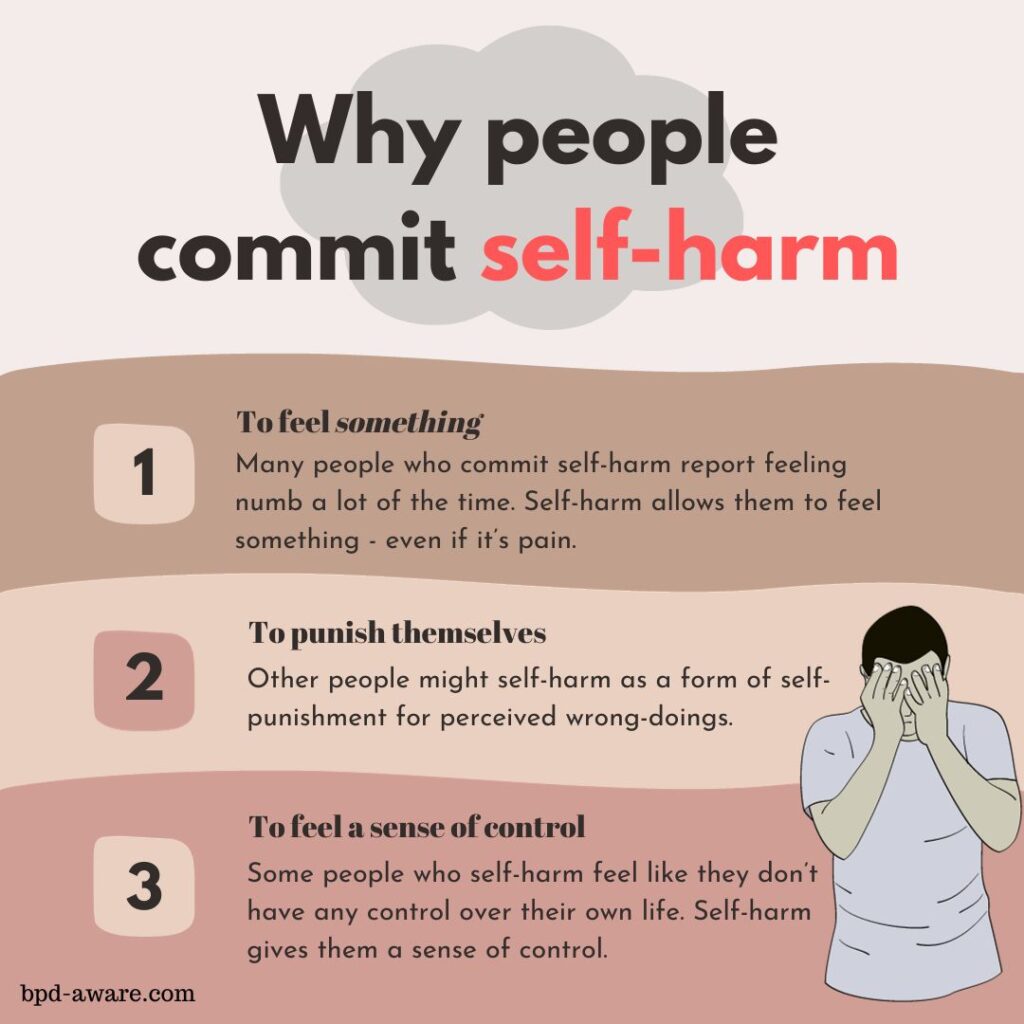Among the many symptoms of Borderline Personality Disorder (BPD), one of the most concerning is the desire to self-harm. Not everyone with BPD has these desires but some do and many of those who do act on their self-injurious desires.
This article aims to explore why someone with BPD might engage in self-harm, the type of self-harm they may engage in, the emotions and thought processes involved, and pathways to recovery.
Understanding Self-Harm in BPD
Self-harm in individuals with BPD is a multifaceted issue. It’s important to recognize that self-harm is not a disorder in itself but a symptom or coping mechanism. Common forms of self-harm include cutting, burning, tearing at scabs or hair, or hitting oneself. Abusing substances such as alcohol or illicit drugs is also considered a form of self-harm.
People with BPD often experience intense emotional pain and instability. They might feel overwhelming anger, sadness, emptiness, or fear. Self-harm can emerge as a misguided way to manage these unbearable feelings. For some, it’s a means to express emotions they can’t verbalize; for others, it’s a way to feel something when they feel numb.
The thought process behind self-harm in BPD is complex and varies from person to person. It can be a form of self-punishment for perceived faults or failures. Some individuals believe they deserve the pain. Others might use self-harm to break through emotional numbness, to feel real or alive. Paradoxically, self-injury can also be a means to gain control when life feels chaotic or overwhelming.
The emotions that cause someone to self-harm are often described as something that builds until they can’t be denied any longer. It can feel like denying yourself oxygen. You try to hold your breath for as long as you want but eventually, you have to give in and take that deep breath in to restore your being.
Because self-harm can create a sense of control, the self-harmer can feel a tremendous sense of relief shortly after the act. Feeling in control when you have BPD can be rare, so this feeling can lead to self-harming becoming addictive.
Physically, self-harm can lead to scars, infections, and in severe cases, life-threatening injuries. Psychologically, it can reinforce negative self-beliefs and create a cycle of guilt and shame. The temporary relief it provides is overshadowed by long-term detrimental effects on mental health.

Myths about Self-Harm
For someone who’s never considered harming themselves, the idea of self-harm can be extremely difficult to understand. To harm yourself goes against most people’s nature and feels completely foreign as a concept. Because of this, myths and stigma about self-harm have developed.
Some people believe that self-harm is a cry for attention. Typically, self-harmers go to great lengths to hide the damage they’ve done to themselves and feel guilt and shame about their actions after the fact.
It’s also a common misconception that everyone who self-harms is also suicidal. While there can be a crossover, it’s not necessarily the case.
Another misconception is that only teenagers or girls self-harm. Again, this is not the case. People of all genders and ages are prone to self-harm.
Breaking the Cycle of Self-Harm
- Professional Therapy: Therapies like Dialectical Behavior Therapy (DBT) are effective for BPD and self-harm. They focus on building coping skills, emotional regulation, and distress tolerance.
- Understanding Triggers: Identifying what triggers the urge to self-harm is crucial. It could be certain people, situations, or emotional states. These triggers should be avoided while you learn coping strategies to deal with them.
- Developing Healthy Coping Mechanisms: Replacing self-harm with healthier coping strategies like exercise, writing, or engaging in hobbies can be beneficial.
- Building a Support System: Having a supportive network of friends, family, or support groups can provide emotional support and accountability.
- Self-Care and Mindfulness: Practices like meditation, yoga, and self-care routines can help manage stress and emotional dysregulation.
Helping a loved one who self-harms
To help a loved one who self-harms is important to educate yourself on the subject. Reading this article is a great start but we can only go so deep in a single article. A great book to read would be Freedom From Self-Harm by Kim Gratz PhD and Alexander Chapman PhD. It goes much more in-depth about self-harm and includes several DBT skills and exercises you can encourage your loved one to try. We do not receive any money for linking to this book, it’s just an honest recommendation.
You may also want to consider the following advice:
- Approach with Empathy and Without Judgment: Approach the person with care and empathy. Avoid judgmental or shocked reactions, as these can make the individual feel more ashamed or misunderstood. Express your concern for their well-being in a non-confrontational way.
- Listen and Offer Support: Encourage them to talk about their feelings and listen attentively. Let them know that you’re there to support them without trying to force them to stop or make them feel guilty about their behavior.
- Avoid Simplifying Their Feelings: Don’t dismiss their problems or suggest quick fixes. The issues leading to self-harm are often complex and deeply rooted.
- Encourage Professional Help: Gently suggest the idea of seeking help from a mental health professional. Offer to assist with finding a therapist or to accompany them to appointments if they’re comfortable with it.
- Help Identify Triggers and Alternatives: Work with them to identify triggers that lead to self-harm. Encourage them to develop alternative coping strategies, such as exercise, writing, or other creative outlets.
- Be Patient and Understanding: Recovery from self-harm can be a slow and challenging process. Be patient and understanding of their struggles. Recognize and acknowledge small steps of progress.
- Take Care of Yourself: Supporting someone who self-harms can be emotionally draining. Ensure that you also take care of your own emotional needs and seek support if necessary.
- Stay Informed on Crisis Resources: Be aware of crisis intervention resources, such as hotlines or emergency services, in case the person is at risk of serious harm or suicide.
- Maintain Boundaries: While supporting someone, it’s important to maintain healthy boundaries for your own well-being. Know your limits in terms of what support you can provide and encourage them to build a broader support network.
- Promote a Supportive Environment: Encourage an environment that supports healing and recovery. This includes fostering open communication, reducing stressors, and promoting activities that boost self-esteem and well-being.
Remember, the goal is to support your loved one in finding healthier ways to cope with their emotions and to seek professional help if needed. Your support can make a significant difference, but it’s also important to recognize that ultimately, the decision to stop self-harming and to seek help lies with the individual. You can’t – and shouldn’t – try to force the situation as this can do more harm than good.
Final Thoughts
Understanding the link between BPD and self-harm is vital for effective treatment and recovery. It’s a complex issue rooted in emotional pain, unstable self-image, and a lack of healthy coping mechanisms. Someone who self-harms shouldn’t be judged or belittled for their maladaptive behavior. They should be listened to, supported, and encouraged to seek professional help where possible.
With professional help, support, and the development of healthier coping strategies, people with BPD can smash the cycle of self-harm and move towards a healthier, more stable life. Recovery takes time and support and can be a difficult period with many ups and downs. However, the result is more than worth it.
If you’d like to share your experiences with self-harm, whether they’re your own experiences or those of a loved one, we’d love to listen. We would appreciate trigger warnings where necessary if you choose to go particularly in-depth about your experiences. Thank you for reading!
Sources, Resources, and Further Reading
- Self-Mutilation and Borderline Personality Disorder: https://www.verywellmind.com/self-mutilation-425484
- How to Deal with Self Harm: https://www.crisistextline.org/topics/self-harm/#what-is-self-harm-1
- Mental Health Help Lines: https://www.mhfirstaid.tools/help-lines
- BPD and Self Harm: https://www.bpdworld.org/self-harm.html
















